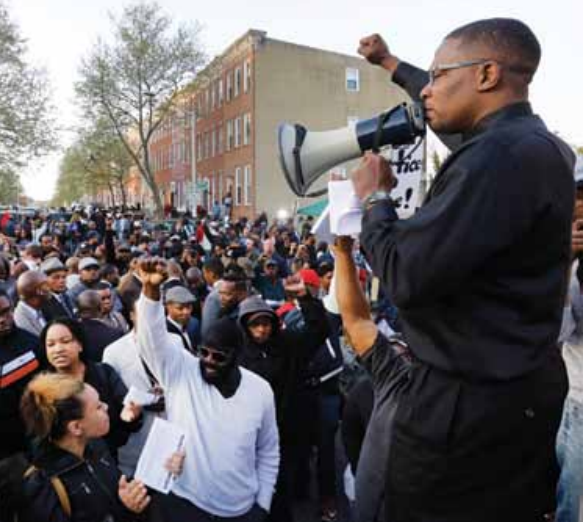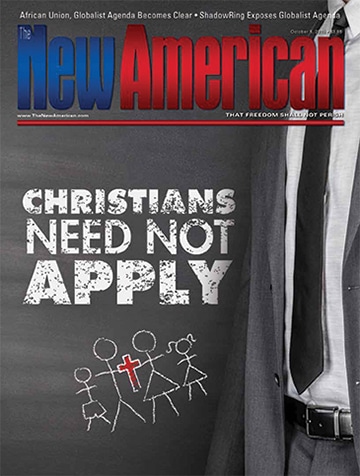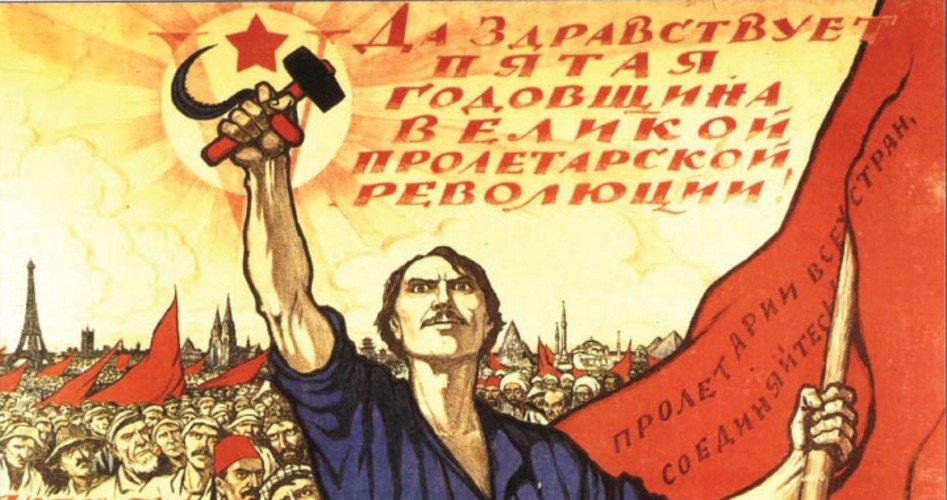The Communist Pedigree of the Clenched-fist Salute
Riots, protests, demonstrations, rallies; pick the issue — police brutality, racism, Occupy Wall Street, oil and gas fracking, minimum-wage legislation, education funding, etc. — it’s a sure bet a certain symbol will be ever-present.
When Baltimore erupted in flames, riots, and looting, the “protesters” — from unknown teens to infamous agitators — prominently displayed the clenched-fist salute. The same clenched fist appeared on rally posters and banners, along with “#BlackLivesMatter” and “Hands Up, Don’t Shoot!” Malik Zulu Shabazz, the hate-spewing former head of the New Black Panther Party (and current national president of Black Lawyers for Justice) conspicuously employed the clenched fist salute while leading chants and rallies in Baltimore. (See picture below.) It was a repeat of the violence-promoting rallies that exploited the “racial justice” theme and fomented racial turmoil nationwide following the Trayvon Martin shooting in Florida and the Michael Brown police shooting in Missouri.

In Ferguson, Missouri, black rioters and looters went on a rampage, spurred on by the media, which falsely portrayed Michael Brown as “the gentle giant,” another unarmed young black man shot down in cold blood by a white police officer, according to the media storyline. Protesters took to the streets with their clenched fists raised, led by the professional organizers of the Black Lives Matter movement, the New Black Panther Party, the Communist Party USA, and the Revolutionary Communist Party (RCP).
Black protesters with their clenched fists raised in the air were photographed and displayed on the cover of Revolution, the official newspaper of the Revolutionary Communist Party. Elaborating about the many “great things that are happening” in the Communist Party USA, party chairman John Bachtell told Gawker.com in an interview, posted on August 15, 2015, “Black Lives Matter has played an important role.” This is not surprising, since, as The New American has reported, the co-creators of the #BlackLivesMatter slogan that suddenly appeared on posters, T-shirts, Tweets, and protest banners are Patrisse Cullors, Alicia Garza, and Opal Tometi, three radical lesbian Marxists who identify themselves as “queer Black women” and who idolize former Communist Party leader Angela Davis and communist terrorist/cop-killer Assata Shakur.

It is much the same story in more localized mob actions, such as the violent and disruptive protests staged in Wisconsin during 2011 — and beyond. The 2011 Wisconsin Budget Repair Bill, otherwise known as Act 10, passed by the legislature and signed by Governor Scott Walker, was a major smackdown to the radical unions, effectively ending collective bargaining for most public-sector employees. Both in the weeks leading up to and months following its passage, the Wisconsin State Capitol in Madison was flooded with protesters in opposition to the bill. These demonstrators consisted of the usual AFL-CIO labor union members, Occupy Wall Street activists, and Marxist-Leninists, including members of the Communist Party USA and the Revolutionary Communist Party. The RCP is a hardcore Maoist party led by Bob Avakian, whose pedigree dates back to his leadership in the Students for a Democratic Society (SDS) and their violent demonstrations in the 1960s and ’70s. This coalition of communists, AFL-CIO members, and Occupy protesters displayed red banners, flyers, posters, and T-shirts depicting an upright clenched fist.
The clenched fist, which is a favorite symbol and gesture of Wisconsin union activists, the Occupy movement, and Black Lives Matter, is entirely revolutionary and communist. And even though many of the demonstrators/rioters using the gesture and sporting brochures and signs emblazoned with the symbol have little or no knowledge of its origin and meaning, we can be sure that the principal organizers promoting its usage understand precisely the importance of ingraining this — and similar symbols — into the popular culture.
The public literature and slogans of the various communist parties are replete with what is known as “Aesopian language,” allowing its authors to propagate a specific message understood to their ideological adherents but unbeknownst or seemingly benign to the average unsuspecting person.
The longstanding definitive Webster’s Third New International Dictionary of the English Language Unabridged defines “Aesopian” as “language only understood by those indoctrinated in such verbiage.” The more recent 11th edition of Merriam-Webster’s Collegiate Dictionary is even more explicit, defining “Aesopian” as “conveying an innocent meaning to an outsider but a hidden meaning to a member of a conspiracy or underground movement.” Plainly put, for the purposes of this article, “Aesopian language” is communist communication concealed in public view.
In Wordmanship: Semantics as a Communist Weapon, a study prepared for the U.S. Senate Subcommittee on Internal Security in 1961, Stefan T. Possony, the Hoover Institution’s director of international studies, traces the use of this practice to Vladimir Lenin, who “employed Aesopian expressions to get by the tsarist censor.” Of Lenin’s use of “Aesopian language,” Possony elaborates:
He masked “Communists” as “strict Marxists” and instead of using the taboo word “revolution,” talked about “the reform,” not to be confused with “reforms” which became an Aesopian term dear to moderate Socialists. By now, most of the original Communist vocabulary has been given an Aesopian equivalent. “Dictatorship of the proletariat” grew into “democracy,” “expropriation” was transformed into “planning,” “revolution” was camouflaged as “liberation,” “the party” became “the people” or “the peace movement,” and “communism” was disguised as “anticolonialism,” “anti-imperialism,” and “antifascism.”
The purpose of this coded vernacular was to achieve specific results. “To the Communists, words are tools to achieve effects, not means to communicate in search of truth,” writes Possony. This thought is also conveyed in Doubletalk: The Language of Communism, where author Harry Hodgkinson writes:
The language of communism … is not so much a means of explaining to an unbeliever what communism means, but an armory of weapons and tools intended to produce support or dissolve opposition to communist policies on the part of people either hostile or indifferent to them. The meaning of a communist word is not what you think it says, but what effect it is intended to produce.
Thus in communism, words and phrases are not defined by the meanings found in a dictionary but by the actions they elicit. This is the essence of “Aesopian language.” Symbols and gestures are also principal components of the Marxian “Aesopian language.” Among the most well-known symbols and hand gestures for communists and their fellow travelers is the raised clenched fist.
Seemingly benign to the average unsuspecting person, the clenched fist has been a longtime symbol for Communist Party-controlled or Marxist-inspired labor, union, and solidarity activists.
Origins and Rise of Communism
Asked about the clenched fist’s esoteric origins, John Lautner, a former top official of the Communist Party USA, told American Opinion magazine (forerunner to The New American) in 1970:
The clenched-fist salute has been used among revolutionaries for many centuries as a symbol of defiance, comradeship, and solidarity. It was employed during the bloody French Revolution of 1789, and again during the industrial revolutions of 1848. At the formation of the First International in London in 1864 (known as the International Workingmen’s Association), Karl Marx and his followers gave the clenched-fist salute, as did his followers at Brussels in 1889 during the formation of the Second International, the so-called Yellow International. And, it had been used by the revolutionary Communards in the Paris Communes of 1871, a violent affair which led to the deaths of over 25,000 Parisians. Since the Third International, the Comintern begun at Moscow in 1919, it has been the official salute of all Communist Parties throughout the world.
Communists in Russia, known as Bolsheviks, continued to use the clenched fist as their official salute even after the 1917 October Revolution. According to the October 2008 issue of Proletarian, the official newspaper of the Communist Party of Great Britain (Marxist-Leninist) (or CPGB-ML), “The raised clenched fist, first known as the ‘Red Salute’ was used as a greeting by Bolsheviks in the Soviet Red Army during the Russian civil war and war of intervention and has become an international symbol of liberation fighters and workers in struggle.”
Following the Bolshevik victory in the Russian civil war, the raised clenched fist, along with the red star and the hammer and sickle, quickly became the symbols of choice for the official communist parties and leftists throughout Western Europe and Asia.
On March 1, 1926, the raised clenched fist received official patent protection from the State Patent Office in Germany, for use as the trademark of the Roter Frontkämpferbund (RFD; German for “Alliance of Red Front-Fighters”), which was a paramilitary organization under the leadership of the Communist Party of Germany. Having been first introduced on the badges worn by members of the RFD in 1924, the clenched fist became a distinctive feature visible on all RFD insignias. In 1933, following the dissolution of the Weimar Republic with the rise of Adolf Hitler and the Nazi Party, the Left in France adopted the clenched fist in solidarity with the defeated German Communist Party.
Clenched Fists in Red China
On August 1, 1927, the Chinese Civil War commenced between the nationalist Kuomintang-led government of the Republic of China, led by Chiang Kai-shek, and the USSR-backed Soviet Republic of China led by Mao Tse-tung, a student of Marxism-Leninism trained in Moscow. The same day as the civil war broke out, Mao’s top military henchmen Zhu De, He Long, Ye Jianying, and Zhou Enlai organized the People’s Liberation Army (PLA) under the control of the Communist Party of China.
On January 31, 1949, PLA forces triumphantly celebrated the Kuomintang surrender of Peiping (now Beijing) with their clenched fists raised in the air saluting Mao. A year and a half later, on May Day 1950, the Chinese Civil War officially ended as Mainland China fell under the total control of Mao and the Communist Party.
Chiang Kai-shek and the surviving Kuomintang forces retreated to the island of Formosa (Taiwan), where they established the Republic of China government-in-exile, with Taipei as its new capital.
In July 1968, Chinese artist Liu Chunhua unveiled his famous oil canvas portrait of Mao, entitled “Chairman Mao goes to Anyuan.” Officially recognized as a cultural relic in Communist China in 1998, the painting depicts a young visionary Mao garbed in traditional Chinese attire with a closed old umbrella under his right arm and a clenched fist on his left.
Expounding the significance of the painting Liu Chunhua explained, “His clenched fist depicts his revolutionary will, scorning all sacrifice, his determination to surmount every difficulty to emancipate China and mankind and it shows his confidence in victory.” Wherever communism spread, a clenched fist was always present.
Clenched Fists USA
In the United States, about 20,000 delegates at the Ninth Convention of the Communist Party USA, held in New York City in 1936, raised their clenched fists in the air saluting top Communist Party dignitaries, including then-party chairman Earl Browder, who jubilantly returned the gesture.
That same year members of the “Old Guard” faction of the Socialist Party of America formed a new party known as the Social Democratic Federation of the United States of America (SDF), after a split in their 1934 national convention. The split resulted from the more radical youthful branch of the Socialist Party, who advocated for “direct action” and open cooperation with the Communist Party.
In his book The Good Fight, Louis Waldman, one of the “Old Guard” members who left the Socialist Party to start the SDF, noted of the young “Militants,” as they called themselves:
When they first appeared on the scene, they wore blue shirts and adopted the upraised arm and the clenched fist as a form of salute. They insisted that the party … do the things that the Communists had made popular in their day-to-day activities. The Militants also proposed that, as the Communists had done, we form separate organizations for the unemployed, youth, tenants, and housewives, as if those groups had interests distinct from those of the workers as a whole....
In due time, organizations of students, youths, tenants, housewives, and the unemployed formed by the Socialist group entered United Fronts with like organizations under Communist auspices. The fronts became transmission belts for the Communists.... Most of the fronts sought to carry out the objectives of Soviet foreign policy, to glorify the Soviet system, and to spread confusion in the ranks of society. [Emphasis added.]
Adopting the Communist Party’s clenched fist salute, the Socialist Party essentially became a front for the Communist Party to fulfill the directives of Moscow. And as did the Communist Party, the Socialist Party would also develop smaller targeted front organizations to achieve those aims.
With the rise of the civil rights movement in the United States during the 1960s, militant black groups began appearing, such as the Black Panther Party. Under the veneer of Black Nationalism and civil rights, the Black Panther Party likewise advocated against capitalism and promoted Marxism-Leninism. Huey Newton, who along with Bobby Seale founded the Black Panther Party, was well-versed in the writings of Malcolm X, Che Guevara, Karl Marx, Vladimir Lenin, and Mao Tse-tung. As the Socialist Party had done in 1934, the Black Panther Party also adopted the clenched fist salute.
The Black Panther Party helped mainstream the clenched fist in American culture, especially among radical black nationalists and civil rights activists as the “Black Power salute.” The Communist Party’s salute soon became the symbol and embodiment of the Black Power movement of the 1960s and ’70s. This was most evident during the 1968 Summer Olympics, hosted in Mexico City, when after the 200-meter race both African-American gold medalist Tommie Smith and bronze medalist John Carlos raised their clenched fists.
The clenched fist became a symbol of Black Power as it simultaneously represented the most ardent elements of communism. Like the Socialist Party in 1934, the Communist Party USA also experienced its own split in the fall of 1961, when the anti-revisionist or pro-Stalinist faction of the party, known as the “Progressive Labor Movement,” led by Milt Rosen, left and founded the Progressive Labor Party in January 1962.
Fully embracing an ideology of Marxism-Leninism-Stalinism, the Progressive Labor Party’s official logo is a red star behind a raised clenched fist with the motto “Fight For Communism” semi-circling the top half and the Spanish translation, “Luche por el Comunismo,” semi-circling the bottom half. This logo also appears on the top right-hand corner of the cover of Challenge, the official newspaper of the Progressive Labor Party.
It is not just the motto inscribed above the logo of the Progressive Labor Party that tells one its objective is “communism,” but also the Aesopian use of the clenched fist as its graphic logo.
In its early years, the Progressive Labor Party worked with the Black Power movement and Students for a Democratic Society (SDS), which, like the Progressive Labor Party, was also founded in 1962.
A leading organization in the New Left movement of the 1960s, SDS was a radical Marxist student organization. The national secretary of SDS was Mike Klonsky, the son of former Communist Party USA leader Robert Klonsky.
The two most prominent individuals to emerge from SDS were its inter-organizational secretary Bernardine Dohrn and her husband Bill Ayers, the two founders of the terrorist Marxist-Leninist Weather Underground Organization. Backed by Communist Cuba’s intelligence service the DGI, the Weather Underground initially arose as a faction of SDS and was responsible for various bombings in Chicago and New York City in the late 1960s through mid 1970s.
Although SDS was officially dissolved in 1969, a new SDS was reorganized in 2006. The official logo of SDS features a red raised clenched fist.
Clenched as “Cool”
The clenched fist remains a symbol of Black Power, as evident by its contemporary usage from both the New Black Panther Party and Black Lives Matter. Members and activists from both the New Black Panther Party and Black Lives Matter often give the clenched fist salute during protests. In fact, the official logo of the Black Lives Matter organization, depicted on both its official website and Facebook page, is of a hooded African-American with his or her arm raised in the air making a clenched fist.
The average American who views the clenched fist as just a cool or faddish “fist pump,” or as simply a cry for black racial justice and equality, fails to understand what the editors of Challenge, Proletarian, People’s World, The Militant, and Revolution know when they print images of a clenched fist on the covers of their newspapers.
The simple fact that so many young people, and even certain conservative presidential candidates, who should know better, also fail to see this and even at times embrace this hand gesture, regardless of intention, highlights the serious lack of education among conservatives and validates the Aesopian nature of this symbol in American culture. Symbols and hand gestures have as much meaning as any other word in the dictionary, and it’s past time we recognize the clenched fist for what it has always meant.
Image at top depicting three communist symbols — clenched fist, hammer and sickle, and red star — together: 1922 Soviet poster dedicated to the Bolshevik Revolution of October 1917; photo showing Malik Zulu Shabazz giving clenched-fist salute: AP Images; photo showing "Standing With Wisconsin" signs: AP Images


